Are you thinking of selling your products online? If yes, which is the best method of selling products online? The concept of online selling may appear to be quite simple and easy, however, you need many reliable tools to get started. Some examples of the tools are SamCart and Shopify.
What makes these two tools different and unique? Which tool is the best option for your business? Here, we take you through both the SamCart vs Shopify that will help you understand how these two differ and for whom are they best suited? So, let's go on the journey of starting your business of selling products online.
SamCart Vs Shopify 2020: Which One Is The Best For You?
SamCart Overview
In the year 2013, Scott Moran and Brian Moran founded SamCart, which is a web-based platform for checkout pages. It has been created to be amongst the best in online shopping carts, and it is continuously improving. Irrespective of whether you wish to sell physical or digital goods, users can create some functional checkout pages in no time. You have to first set up your payment gateway which is with Stripe and Paypal.
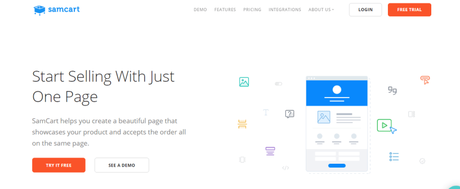
SamCart offers a lot of options in terms of payment methods like payment plans, subscriptions, trials, different currencies, shipping options, one-time payment, etc. It also comes with 18 different checkout templates that have been tested for conversions. It also consists of a very famous template- the one-page funnel. The templates can be easily customized. The platform has a lot of integrations in terms of emails, payments, marketing, etc.
Shopify Overview
Shopify is a fully developed e-commerce platform since the year 2004. Shopify isn't specific to any particular category of business, activity, or approach. Instead, the platform has been built for every person who wishes to sell. The platform serves every business type and is very flexible that it facilitates any e-Commerce system or activity, inclusive of sales funnels.

Shopify has a lot of appealing storefront templates for site building which could be edited as per your preferences and requirements. You can make use of these to create your checkout page or even a sales funnel. The process of customization does not call for special technical skills. On Shopify, you have a website builder that has a drag-drop feature and has an interface that offers smooth as well as seamless editing. The developers aren't left behind as well. In case you are an expert when it comes to coding, you can check out the templates code of Shopify and edit the layouts with a few tweaks in HTML along with CSS tweaks.
The Shopify app store has a lot of integrations in terms of the e-commerce functionalities, which cover the majority of digital business processes - marketing, store designs, payment processing, order management, customer support, inventory management, accounting, product research, etc. There are numerous apps for every process.
For beginners, Shopify has a simple Lite Package which has solid integration capabilities. This is quite useful when you have to create simple checkout pages on your social media sites, third-party websites and blogs.
SamCart Vs Shopify - Features Comparison
SamCartSamCart was created to be a better option for the very bland checkout page you can see on PayPal. The checkout page was very simple. However, despite the evolution, the old simple approach has been retained in terms of online selling. At present, SamCart has become an established shopping cart app for all those who are not good at coding. An account can be set up easily and you do not need technical assistance to sell your products. SamCart's interface is neat and intuitive, it isn't very flashy and confusing.
The various functions have been laid in a manner that novices can navigate around quite easily. In case you require assistance, SamCart has a lot of guides as well as tutorials in addition to a great customer support team. The checkout page can be created quite easily and can be integrated with the Stripe or PayPal account. SamCart does not just cater to the novices but also takes care of advanced online businesses that have sales of millions annually. In case you want to set up an affiliate program, SamCart can help you launch it in a very simple way. It also grants you complete unrestricted control of the affiliate programs you create without any complication.
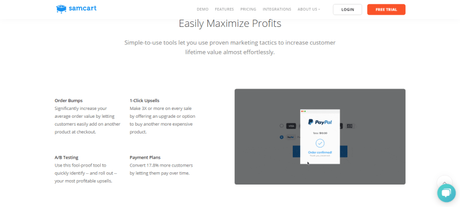
SamCart is also flexible when it comes to the compensation structure - you can specify your commission system for each product. In case you want to fix different rules for a few members, you can create a "VIP Affiliate" framework of payment.
However, SamCart is not a fully developed e-commerce platform like its counterpart, Shopify. So, you might not have a similar level of functionality. But, if your priority is to be simple and aim at fast-selling, SamCart is worth it.
ShopifyThere are a lot of mixed reactions about Shopify when the discussion is about ease of use. Though it is considered to be a user-friendly platform by many, a few have also found it to be quite cumbersome. Yes. Shopify is simple yet complex and this depends on how the user wishes to use the platform.
If you aim at an online store that is fully-functional, then Shopify appears to be amongst the simplest and easiest platforms in e-commerce. Also, there is no necessity to possess technical skills. Shopify also helps in avoiding the entire process of creating a website, by giving you a lot of appealing predesigned templates. All you have to do is tweak it up and create your own website. The templates are responsive and are compatible with PCs or mobile devices. It also offers a default payment solution. So, you need not hunt for some third-party payment gateway, although it is recommended to include many payment options on an online store. Shopify Payments also handle most of the debt as well as credit cards.
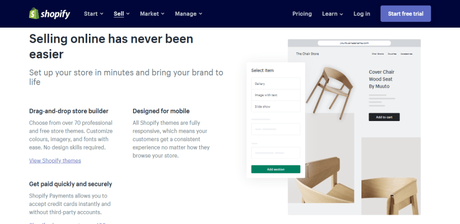
When the site goes live, Shopify has some straightforward store management processes, wherein you can switch between orders, products, analytics, customers, etc. easily. Irrespective of the business, this interface gives you a seamless experience.
But, an issue faced here is that the entire process of creating along with managing the sales funnels on Shopify is not direct like in SamCart. You can use the "Pages" section to create your landing page, however, there aren't many default functionalities with respect to sales funnels. Though Shopify has a very user-friendly system, it falls back in its ease of use. Overall, it is easy for SamCart for various sales funnels. On the contrary, Shopify is a great platform for bonafide online shops.
SamCart has about 18 templates that are professionally designed and quite attractive in its funnel builder, which will help in setting up your sales funnel in no time. You can choose any template at no extra cost. Every template has been tested by many marketers on their pages to evaluate the results. So, the templates of SamCart are not just optimized for conversion, they are effective as well.
SamCartIn case you wish to modify any of the templates or layout elements, SamCart has a simple process of customization. Once you select the template, the layout colors can be adjusted, the text can be edited and various buttons can be tweaked. The templates are mobile-ready and respond to both PCs as well as mobile devices.
SamCart TemplatesShopify also offers some pre-designed templates that are beautiful, modern and professional. However, there are no templates for the checkout pages. Instead, it has online store themes, which has its own webpage set. There are about 74 themes of which just 10 are free. The rest are available at a cost of $140-$180 as they are premium e-commerce themes. This platform has a great in-house team of designers and developers who can design a totally new theme for the site, in case price doesn't bother you. The editing options are better than SamCart and in case you excel at web development, you can check out the codes of Shopify and tweak the templates.
ShopifySamCart and Shopify have many templates for merchants, however, the main difference here is that SamCart focuses on checkout pages, whereas Shopify focuses the themes on online stores that are fully developed. SamCart's templates are all free of cost, whereas Shopify, charges a good sum for most of its themes.
SamCart, though a very simple application for sales funnels, it has an array of amazing e-commerce features. It can accommodate physical as well as digital or subscription-based goods. So, in SamCart you can sell anything! You must make use of the split testing tool of SamCart before you roll out your campaign. It helps in assessing the conversion potential of the checkout pages. What it does is that it compares the results from two versions of the same page.
SamCartAnother great feature of SamCart is its affiliate system, where you can leverage other marketers through the strategic affiliate programs. There are a lot of useful features such as one-click up-sell which can boost your potential earnings at the time of checkout. It tempts customers to buy more goods by using just a single click to add them to the cart. There are two gateways to process the transactions - PayPal and Stripe. SamCart helps in minimizing the rate of cart abandonment by ensuring the buyers are on the page. Subsequently, they end up making payments through the popup.
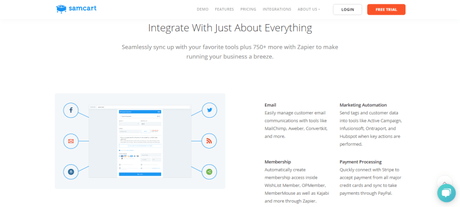
In SamCart, the shipping charges, are applied automatically to the orders of your customers' depending on the rate that you have fixed for different geographical locations. However, you can also fix a flat rate for every order.
In subscription-based packages, the subscription Saver is amongst the best features which can be used. You can remind subscription customers automatically to update their payment details on the expiry of their credit cards.
Since Shopify is amongst the established e-commerce platforms, it is expected that they offer all the core functionalities of online selling. And, yes, Shopify does not disappoint in this aspect! On Shopify, product management is quite comprehensive. Numerous products, as well as categories, can be added as there aren't restrictions. You can select what you wish to sell - digital or physical goods.
ShopifyHowever, in case you wish to build a business that is subscription-based, you could incur some additional costs. Shopify does not have this feature on the default system. Hence, you either pay the developer or you integrate an app that is compatible and supports the recurrent packages. Irrespective of the products chosen, you must be in a position to sell those on your site, on third-party websites, and also social media platforms such as Instagram, Pinterest, Facebook, along with Marketplaces such as eBay or Amazon.
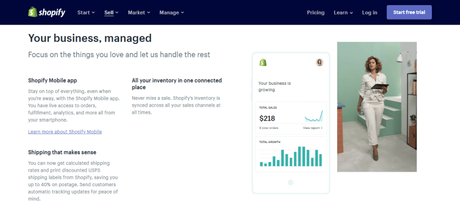
Shopify has plenty of tools that are available to boost your sales. For example, you can set some automatic discount codes for your customers or even come up with a loyalty program. Though it is possible to cross-sell as well as up-sell, you will have to embed the relevant apps from the App Store of Shopify. Even when you customize the payment systems, you have to check out the options on its App Store. However, in case you opt for other options than Shopify Payments, there will be extra transaction processing fees charged. But by using alternative gateways, you can accept payments to many customers.
Shopify applies a dynamic approach to its order fulfillment as well as customer management processes. You can define the parameters of automation for the shipping process. You can also fix the rates based on location or even opt for a flat shipping charge or free shipping.
Though Shopify is a very popular e-commerce platform, Shopify does not limit itself to only online selling and even facilitates the brick-and-mortar stores, via the Shopify POS system.

By this, we can understand that SamCart has the right tools to enable quick as well as easy selling through checkout pages. Other than the A/B conversion tests, different product types can be introduced, affiliate programs can be used, you can even up-sell or cross-sell, etc.
However, this is not quite great when you compare it with the e-commerce features of Shopify. Shopify has been designed to give you all the necessary features of e-commerce. It is not limited to the tools for checkout pages. Shopify gives you many strong third-party integrations. Overall, Shopify is way better in terms of e-commerce than SamCart.
SamCart Vs Shopify: The Pricing Battles
SamCart Pricing Plans
(i) Pro - Features- It costs $99 for a month
(ii) Premium -Features- It costs $199 for a month
Shopify Pricing Plans
(i) Basic Shopify- Features- It costs $29 a month
(ii) Shopify- Features- It costs $79 a month
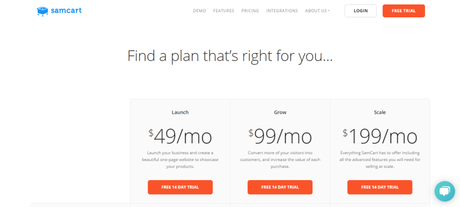
(iii) Advanced Shopify- Features- It costs $299 a month
Who Is The Winner Of Pricing Battle:
SamCart Vs Shopify pricing, both have a payment system that recurs every month, unlike the options such as ThriveCart that provide a large one-time payment that can be used for a lifetime.
Samcart vs Shopify: Pros & Cons
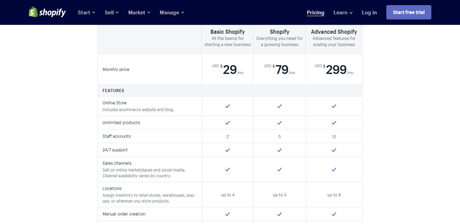
SamCart Pros
SamCart Cons
Shopify Pros:
- It has a very user-friendly platform wherein digital or physical good can be sold online
- SamCart has Sales funnel capabilities like order bumps or one-click up-sell that increases the order value
- It offers advanced statistics reports such as Lifetime Value
- You can easily create Coupon codes (% or $)
- It has different payment models: subscriptions, one-time payment, trials, and payment plans
- You can use A/B split testing on the landing page
- It has a good Knowledgebase
- SamCart has cart abandonment capabilities on the checkout page
- It comes with an in-built Dunning System
- Checkout pages have the Drag-Drop Editor
Shopify Cons
- It supports only Stripe and PayPal
- The Monthly pricing begins at $49 a month
- There are no in-built calculations for digital sales tax
- The Affiliate system does not come with tracking IDs that can be used by affiliates
- It helps the creation of a fast website and reduces the loading time.
- Shopify ensures your site is secure in terms of sensitive data as well as processing payments.
- It has a great design and offers a lot of free as well as paid templates for your site
- It has many add-ons and features can be expanded as required
Customer Reviews- SamCart Vs Shopify
- Shopify is quite expensive and you must consider transaction processing fees in case you do not opt for the default Shopify Payments.
- In case you wish to explore Shopify's back-end, you have to be good at coding or hire someone who is an expert. This could increase costs.
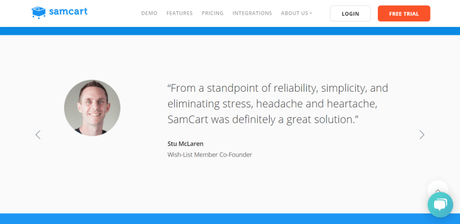

FAQs Of SamCart
FAQs of Shopify
Shopify ReviewsConclusion: SamCart vs Shopify | Which One To Choose ?
In case you intend to sell digital products, SamCart is the best option. It has some great funnel building, amazing sales pages, and also customized class analytics. On the contrary, Shopify is a very expensive platform of e-Commerce which offers simple yet flexible tools for businesses to set up full-fledged online shops, and also helps them grow their subsequent business.
Both these E-commerce platforms are reliable and the choice totally depends on your business - whether you are a digital marketer, or a growing business, or a merchant, or an enterprise. I hope you will get some idea about which e-commerce platform to choose between SamCart Vs Shopify.

